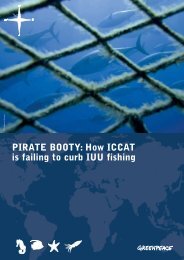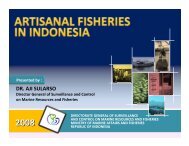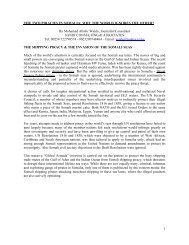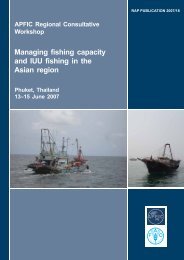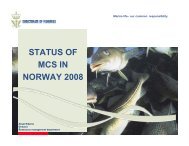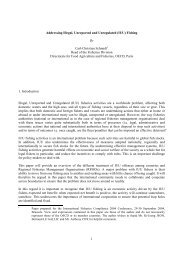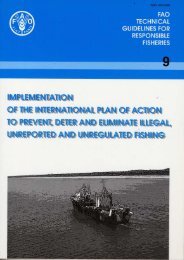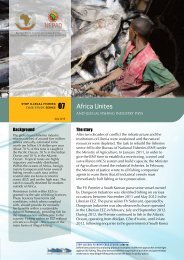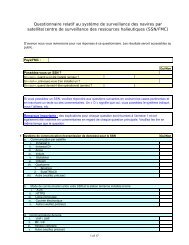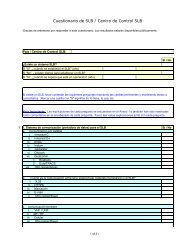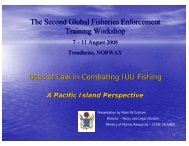Fishing capacity management and IUU fishing in Asia - FAO.org
Fishing capacity management and IUU fishing in Asia - FAO.org
Fishing capacity management and IUU fishing in Asia - FAO.org
Create successful ePaper yourself
Turn your PDF publications into a flip-book with our unique Google optimized e-Paper software.
Unless these pre-requisites are addressed, <strong>in</strong>itiatives to address <strong>fish<strong>in</strong>g</strong> <strong>capacity</strong> issues may not besuccessful. Only five countries of eight who reported (63 percent) stated that more than 90 percentof <strong>in</strong>dustrial vessels were actually registered while only two countries of n<strong>in</strong>e (22 percent) reportedthat more than 90 percent of small-scale, artisanal vessels were registered 2 . Vessel registrationsystems <strong>in</strong> the region therefore appear generally <strong>in</strong>effective <strong>and</strong> therefore may not be useful tool forthe essential measurement of <strong>fish<strong>in</strong>g</strong> <strong>capacity</strong>. To implement <strong>and</strong> measure the impact of any<strong>capacity</strong> limitation <strong>in</strong>itiative under these circumstances will be extremely difficult, unless eitherthe vessel registration systems are made more robust or alternative measures of <strong>fish<strong>in</strong>g</strong> <strong>capacity</strong>(e.g. a regular census of vessels) are adopted. It is likely that the most appropriate tool formeasurement of <strong>fish<strong>in</strong>g</strong> <strong>capacity</strong> <strong>in</strong> the region will be different for large-scale, <strong>in</strong>dustrial vessels(where vessels registration systems are already reasonably well developed) than for small-scalefisheries where other methods such as vessel census may be more appropriate.One approach to manag<strong>in</strong>g <strong>capacity</strong> reported by some countries was the imposition of a ban on theissue of new vessel licenses <strong>and</strong> to reliance on attrition to reduce the numbers of vessels <strong>in</strong> a fishery.However, unless this is accompanied, at least, by a robust vessel registration process <strong>and</strong> goodcontrol <strong>and</strong> surveillance (both of which are often lack<strong>in</strong>g), such an approach is unlikely to beeffective <strong>in</strong> reduc<strong>in</strong>g <strong>fish<strong>in</strong>g</strong> <strong>capacity</strong>, s<strong>in</strong>ce the most likely result would simply be an <strong>in</strong>crease <strong>in</strong> thenumber of unregistered vessels.Conclusion: The vast majority of countries of the region have now recognized <strong>fish<strong>in</strong>g</strong> <strong>capacity</strong> asan issue that requires <strong>management</strong> <strong>and</strong> that there is a need to move from open access fisheries tosome type of restricted or controlled entry. However, the essential pre-requisites for restrict<strong>in</strong>g orcontroll<strong>in</strong>g entry (particularly <strong>in</strong> small-scale, artisanal fisheries) of enforceable vessel <strong>and</strong> fisherregistration systems <strong>and</strong> <strong>fish<strong>in</strong>g</strong> effort data collection systems are not yet <strong>in</strong> place <strong>in</strong> many countries<strong>and</strong> therefore it is likely that <strong>in</strong>itiatives to address <strong>fish<strong>in</strong>g</strong> <strong>capacity</strong> issues will not be successful.Moreover, the common absence of these registration <strong>and</strong> data collection systems may also meanthat measur<strong>in</strong>g the effectiveness (if any) of <strong>capacity</strong>-reduction <strong>in</strong>itiatives will be extremely difficult.3.2 To what extent have national plans of action to address <strong>fish<strong>in</strong>g</strong> <strong>capacity</strong> issuesbeen developed?Of the ten responses received, six countries have already developed NPOAs to address <strong>fish<strong>in</strong>g</strong><strong>capacity</strong> with a further three countries plann<strong>in</strong>g to develop these with<strong>in</strong> the next five years (Table 1).Several of these NPOAs have been developed with<strong>in</strong> the last few years (Table 2). Unfortunately,copies have not been provided to <strong>FAO</strong>, <strong>and</strong> casts some doubt on the accuracy of report<strong>in</strong>g on thisitem. It suggests that the questionnaire approach <strong>and</strong> differences <strong>in</strong> <strong>in</strong>terpretation of what constitutesan NPOA may over state the extent to which NPOAs have actually been developed. An example ofthis is a country response to a questionnaire <strong>in</strong> 2003 that an NPOA had been developed, but a morerecent response <strong>in</strong>dicat<strong>in</strong>g that it now has no NPOA <strong>and</strong> has no plans to develop one.Table 2 provides <strong>in</strong>formation, based on responses from the questionnaires, as to how activity <strong>in</strong> thedevelopment of NPOAs on <strong>fish<strong>in</strong>g</strong> <strong>capacity</strong> has changed s<strong>in</strong>ce 2002. In the current survey,66 percent of countries stated that they had already developed an NPOA on <strong>fish<strong>in</strong>g</strong> <strong>capacity</strong>, witha further 25 percent stat<strong>in</strong>g they were plann<strong>in</strong>g to develop one with<strong>in</strong> the next five years. This isa marked improvement over the situation <strong>in</strong> 2002 where only 40 percent of countries stated thatthey would meet a 2005 deadl<strong>in</strong>e for hav<strong>in</strong>g an NPOA on <strong>fish<strong>in</strong>g</strong> <strong>capacity</strong> <strong>in</strong> place. Table 2 also2The measurement of <strong>fish<strong>in</strong>g</strong> <strong>capacity</strong> <strong>in</strong> small-scale fisheries is a particular problem <strong>in</strong> <strong>Asia</strong>, given the large number ofvessels <strong>and</strong> their wide distribution. The methods used to measure <strong>fish<strong>in</strong>g</strong> <strong>capacity</strong> <strong>in</strong> such fisheries (for example, by regularcensus methods) may be quite different from that used to measure <strong>fish<strong>in</strong>g</strong> <strong>capacity</strong> <strong>in</strong> <strong>in</strong>dustrial fisheries, such as robust <strong>and</strong>enforceable vessel licens<strong>in</strong>g <strong>and</strong> registration systems.7



